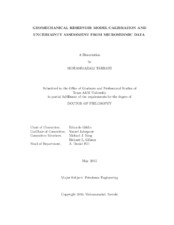| dc.description.abstract | Hydraulic stimulation of low permeability rocks in unconventional reservoirs has been observed to trigger microearthquakes (MEQs). Triggering of the MEQ events has been linked to the pore pressure, temperature, and in-situ stress variations which result in crack initiation. The resulting clouds of micro-seismic events are believed to carry information about the underlying coupled flow, geomechanics, and thermal processes and hence rock hydraulic and geomechanical property distributions. We develop a probabilistic framework called stochastic seismicity-based reservoir characterization (SSBRC) to integrate microseismic events to infer reservoir property distributions. To model the geothermal reservoir stimulation, a fully coupled thermo-poroelastic finite element method (FEM) model has been developed to handle the coupled process of heat transport, fluid flow, and rock deformation. To simulate the stimulation process, an alternate simplistic approach is also acquired based on a major hypothesis that MEQ events are triggered by an increase in pore pressure. Based on this hypothesis, the distribution of the resulting microseismicity clouds can be viewed as monitoring data that carry important information about the spatial distribution of rock permeability. We apply the ensemble Kalman filter (EnKF) to integrate the resulting continuous seismicity map to estimate hydraulic and geomechanical property distributions. We demonstrate that the standard application of the EnKF with such large correlated datasets can result in substantial loss of ensemble spread. We investigate three alternative implementation methods to mitigate this issue.
We first present the methodology proposed for MEQ data integration with the EnKF, followed by a number of examples of applying SSBRC to both forward modeling methods to illustrate the uncertainty underestimation effect when the standard EnKF is applied to large-scale seismicity density map data. We then discuss the proposed methods for improving the uncertainty quantification results and illustrate the effectiveness of these methods by applying them to a number of numerical examples. We also apply and extend the proposed microseismic data integration method to unconventional reservoir with horizontal well and multistage hydraulic fractures to characterize the reservoir and induced fractures.
We also investigate the effect of variogram model uncertainty in the EnKF performance and propose a modified EnKF algorithm to handle the uncertainty in variogram parameters. We also develop a computationally efficient data assimilation procedure by employing a pseudo forecast method and geological model clustering method along with EnKF. By a set of numerical experiments, we show how the proposed fast history matching method is successful in preserving the ensemble spread and expediting the integration procedure. | en |


